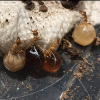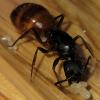Hi everyone! I am really interested in honeypot ants (Myrmecocystus spp) and I am trying to find records of repletism in the 29 different species. In this paper (https://www.scienced...055790320303080), they state repletes have been found in 20/29 species but do not indicate which species. I have been able to find records of repletes in 19/29 species. The ten species I couldn't find records for are christineae, colei, creightoni, intonsus, kathjuli, kennedyi, koso, nequazcatl, perimeces, and romainei. I am attaching a file of all my citations for this information.
I was wondering if anyone here has observed repletism in these species? Any insight/discussion would be appreciated! Thanks ![]()



















